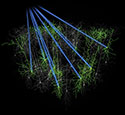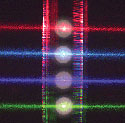|
Wednesday, October 28, 2015
|



|
Multiphoton excitation fluorescence (MPEF) microscopy, an optical imaging technology that’s vital to the life sciences, is advancing as quickly as its applications. The technique is on track to transition to clinical uses within the next several years.
|
|
|
|

|

In Vivo Neural Imaging — SLMs for Conducting 3D Holography
inside Living Brains
Despite the critical role our brains play in perception, cognition and action, we know very little about how the brain actually accomplishes these feats. With the advent of new optical methods for probing neural networks, researchers have begun to untangle the neural web and shed new light on the mysteries of the brain.
|
|
|
|


|
Optically pumped semiconductor laser (OPSL) technology dominates some of the leading applications for continuous wave (CW) and modulatable laser light, including those used for cytometry, sequencing, fluorescence microscopy and ophthalmological photocoagulation. OPSLs have rapidly transitioned from next-generation CW laser technology status to a dominant force within the life sciences.
|
|
|
|

Reduced to the Essentials — Portable Imaging Gets High-Tech
Capable of providing streamlined access to medical data in real time, and with the ability to perform diagnostics in remote areas, portable imaging technologies for medical applications are of increasingly significant interest to medical practitioners and technology companies alike.
|
|
|
|



|
Dual Inverted SPIM
Applied Scientific Instrumentation, Inc.
ASI has developed a new form of light sheet microscopy with our collaborators in the scientific community.
More info >>
|
|

|

|
New: INFINITY3S-1UR
Lumenera Corp.
Lumenera’s INFINITY3S-1UR is a high-speed, high sensitivity research-grade camera with a 1.4 megapixel resolution.
More info >>
|
|

|
|
|

|
|

WHITE PAPER

|
How can I find the right digital camera for my microscopy application?
Basler AG
Nowadays, image processing is found in a wide range of optical microscopy applications. Examples for this are medical and biological research, diagnostics, testing of medicinal products, or material sciences. Microscopy cameras are an important component of these systems and the specific requirements of your application will drive the selection of the most suitable microscopy camera. You will learn the factors guiding the choice of color or monochrome cameras, and the functional differences and benefits of CCD and CMOS sensors, and of the various interfaces. Further, you will learn how sensor and pixel size, resolution and frame rates will influence your camera selection. Choose your microscopy camera wisely, to achieve optimal image quality, and to minimize system costs.
DOWNLOAD WHITE PAPER >>
|
|
|


|

|
|
Photonics Media is currently seeking technical feature articles on a variety of topics for publication in our magazine BioPhotonics. Please submit an informal 100-word abstract to Editor Rodd Pedrotti at Rodd.Pedrotti@Photonics.com
|
|
|
|
sponsor
 |

sponsor
 |


sponsor
 |

sponsor
 |

sponsor
 |

|